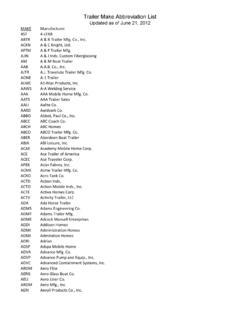Transcription of The Most 10 Common Mistakes Manufacturers …
1 1997 Industrial Performance Group10 The MostCommon MistakesManufacturers MakeWhen Dealing withDistributors & Howto Avoid you re a manufacturer who s decided to take your products to marketthrough independent distributors, you face a host of unique sales, marketing,and management challenges every day. And how well you manage your rela-tionship with your distributors will go a long way in determining your overallsales a company that specializes in helping manufacturersimprove their distributor sales, the Industrial Performance Group has iden-tified some Common Mistakes that Manufacturers make in doing businesswith the distributors that represent their product lines. Following is our Top 10 list of pitfalls to watch out 1997 Industrial Performance Group2 Viewing your distributoras your may send your invoices to them, and it may betheir checks that you deposit in your bank that doesn t make your distributor yourcustomer.
2 The real customer is the personor organization that has a need that s bestmet by the function and attributes of yourproduct. Without them, neither you noryour distributors would be in , you need to view your distributornot as your customer, but as your channel partner who is, in effect, your teammate in making sure theneeds and expectations of the true customer aremet. As such, you need to structure the relation-ship you maintain with your distributors in a waythat will enable you to best meet the customer sneeds and expectations in a way that s profitable forboth you and your to understand yourdistributor s is a margin business. As such, dis-tributors naturally gravitate toward selling thoseproducts that offer the most return on theresources , money, time, & people that they invest. Independent distributorsare just that separate business entitiesthat have their own goals, strategies, andoperating philosophies.
3 And when thoseare at cross purposes with your own, thestage is set for destructive conflict between you andyour solution to this problem lies in recogniz-ing that distributors will act in their own bestinterests and tempering your expectations accord-ingly. Also, you need to work closely with yourdistributors to clearly identify what you expect ofthem and what they can expect from you. Bycarefully defining each other s specific roles andresponsibilities together, you can maximize yourrespective profitability by avoiding costly duplica-tion of effort and preventing the problems thatfrequently arise from unreasonable understanding thecustomer s term value-added is among the mostpopular marketing buzzwords of the many Manufacturers expect their distribu-tors to be the source of that added value for theend users of their products. Distributors fre-quently respond by offering their customersmore and more services from which to in today s highly competitive, fast-pacedmarketplace, more choices may be one of the lastthings that customers want exactly what theyneed, when they need it.
4 Period. Add-ing more services to your offering mayactually make it harder for customers todo business with a distributor. Realvalue for customers comes from helpingthem reduce their overall costs and/or improv-ing their own performance. Therefore, beforeyou and your distributors can truly begin to addvalue for your mutual customers, you need togain a clear understanding of the customers businesses especially those activities that theyperform as they acquire, store, use, and disposeof the products they purchase. Then you andyour distributors can tailor your service setting specific goals fordistributor s an old adage that says, if it doesn t getmeasured it doesn t get done. And thatadage certainly applies to distributorsales performance. By the time mostmanufacturers notice problems withtheir distributor sales, it s especiallytough to do anything about them. Andit s difficult to criticize a distributor forperformance that s not up to your expectationswhen you haven t told them what you expect ofthem in the first place.
5 So you need to work with each and everyone of your distributors to set specific andmeasurable sales goals for them, let them knowthat their performance will be evaluatedthroughout the year, and make sure they under-stand the yardstick against which they ll bemeasured leads generated, quote-to-closeratio, etc. Then monitor them closely so you cantake corrective action quickly if it s 1997 Industrial Performance GroupAssuming that yourdistributors can who has ever been involved in sales will tellyou that selling is hard work. And if yourproduct is anything more than a truecommodity, the chances are good thatgetting the order will depend upon howwell somebody does in answering acustomer s questions and overcomingobjections that frequently arise duringthe sales process. If you re relying solelyon distributor salespeople to perform thesecritical tasks, you could be making a fatal distributor salespeople understand theimportance of learning about a product and how tosell it.
6 But if you take into account how many differ-ent products the average distributor carries and howmuch training would be required to effectivelyprepare them to sell all these different items, you llsee that your distributors ability to effectively sellyour products may be minimal at best. So you needto come to terms with this reality and augment yourdistributor sales efforts with other ways of gettingproduct, sales, and technical information in thehands of prospective that yourdistributors want to s a big distinction between sellingand taking orders. And all too often, adistributor salesperson s approach tosales is to wait for the phone to ring andask, How many do you need? when it sa customer on the line. That method maywork very well for a distributor with a lot ofproducts that tend to sell themselves. But if yourproduct involves considerablepre-sale work or a complex sell, you need more thana bunch of Manufacturers invest a lot of money intraining distributor salespeople about their prod-ucts and how to sell them.
7 But all the sales train-ing in the world won t help improve the perfor-mance of distributor salespeople who are contentto merely take orders. The key is to build distribu-tors commitment to your company. And you cando that by taking steps to make your products moreimportant to the financial success of the distributorwhile at the same time reducing the costs and hassles incurred by the distributor when solely on discountprograms and other spiffs to encourage distributorsto sell your programs are a staple of many manufac-turer-distributor arrangements. And a well-craftedincentive program can be instrumental in helping amanufacturer boost sales, expand its market share,and increase its leverage with its distribu-tors. Unfortunately, many such pro-grams are poorly designed, and resultin nothing more than a lot of productgathering dust on distributors ware-house shelves while the distributors salespeople are off on a vacation trip atthe expense of the manufacturer.
8 Or the focus ofthe salespeople becomes the contest rather than offering discounts, junkets, merchan-dise, and other spiffs to distributors should bestructured so that they encourage distributors tocontinually sell your products rather than simplybuild their inventories when they can get a betterprice. Another important element of a good incen-tive program is to reward distributors for improv-ing their sales s also important that any incentive programsbe tied directly to your company s goals and thestrategy being employed to realize those goals. Andeven more importantly, remember that spiffs alonearen t enough. They have to be supported withcustomer-oriented marketing efforts, trainingprograms, and other to properly managethe relationships you maintainwith your a distribution territory is often a keyactivity for Manufacturers field salespeople. Unfortunately, Manufacturers salespeople rarely are sufficiently trainedin managing distributor when the salesperson doesn t havethe skills to manage the relationship, therelationship manages the that happens, the level of manufac-turer-distributor conflict goes up, sales perfor-mance goes down, and salespeople spend moretime patching things up with their distributors thanthey do in finding and keeping 1997 Industrial Performance GroupTherefore, to better compete in today s highlycompetitive environment, salespeople who areresponsible for dealing with distributors needtraining that covers more than just product knowl-edge and basic selling skills.
9 They also need to betrained in effectively managing the manufacturer-distributor to communicate withyour distributors on a , indeed, is the manufacturer who doesn t havecomplaints about the performance of its indepen-dent distributors. Likewise, distributorsare constantly carping about the poorsupport they receive from the manufac-turers they represent. And in thoseindustries where competition is espe-cially intense or opportunities for growthare declining, minor complaints canquickly escalate into destructive manufacturer-distributor solution is simple. Talk it out. Open, hon-est, and ongoing communication between manufac-turers, distributors, and most importantly customers is the key to reducing conflict and im-proving sales and marketing is the glue that holds a distri-bution channel together. As independent busi-nesses, distributors have a high degree of autonomyin their relationship with a manufacturer.
10 Goodcommunication is therefore critically important inensuring that the activities you and your distributorsengage in are properly aligned and focused. Com-munication also fosters shared values, mutualsupport, improved customer satisfaction, and anadded incentive for your distributors to focus onyour that distributorsare the best way to takeyour products to the past 10 years, dramatic changes haveoccurred in the manner in which manufactur-ers take their products to market. Theemergence of home centers, warehouseclubs, catalog houses, and other alterna-tive channels of distribution haveforever changed conditions in , the availability of electronic commerce be-tween Manufacturers and their ultimate customerscan often eliminate the need for a manufacturer tomaintain outside Manufacturers tend to base their channelmanagement decisions on emotion rather than fact. Our distributors have been with us through thickand thin we couldn t possibly think about leavingthem, is a Common , distribution channels like prod-ucts have life cycles of their own.





